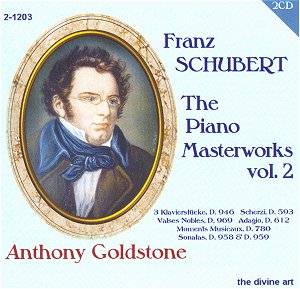The
prevalence of substantial pieces in this programme makes it preferable
to Volume 3, which
I reviewed recently. Perhaps the added weight enabled Goldstone
to appreciate the smaller items the more – the first Scherzo of
D593, a sweet bonbon, is played with evident affection, Goldstone’s
careful rubato raising the odd smile along the way. However, it
is D593 No. 2 that emerges as an unexpected highlight of the set
(QUOTE 1), with its positively glittering right hand. In fact,
Goldstone holds a special affinity for these shorter pieces: the
Valses nobles, D969 are characterised by good, clean playing,
a fine sense of the underlying rhythm and not a small amount of
cheek on occasion!. The Adagio in E, D612 of 1818 is another
discovery (QUOTE 2), a lovely piece handled with great care in
the present instance.
Two
large collections balance out the two Sonatas on offer here. The
Drei Klavierstücke, D946 is a masterpiece (the
three pieces were assembled by Brahms, no less, for publication).
Competition here is fierce: Uchida, Pollini and Pires of modern
interpreters spring immediately to mind, in that order. Goldstone
plays well, yet cannot in truth be said to hold his own in this
exalted company. He takes all repeats and reinstates the
second episode of the first piece, taking the playing time to
half an hour. He manages to hold the attention, though. Tonally,
there is some excellent work, and some lovely, pearly scales enliven
the experience. The first, in E flat minor is unsettled, but not
darkly so, as surely the music demands?. He captures the magical,
intensely Schubertian world of the second well, though; it is
in the third that he most obviously disappoints. Goldstone himself
links this piece to late Beethoven Bagatelles in its unexpected
twists. Perhaps a more exalted tone, a hint of another world,
would have done the work more justice.
The
Six Moments musicaux, D780 are, as Goldstone perceptively
comments, a ‘world of subtle nuance and deep emotion’. As always
in Schubert, simplicity is deceptive and above all, elusive for
the performer. Goldstone is much closer to the heart of the composer
here than in D946. The second piece of D780 (A flat) is especially
impressive in its serenity and interior calm. Similarly, the F
minor third Moment musical (F minor) is given with a lovely
touch. Each, in fact, is individually characterised and yet the
set has the satisfying share of a whole. The rhythmic repetitions
of No. 6 (A flat) take on an affecting pathos that is really quite
moving.
And
so, finally, to the two Sonatas here. The C minor, D958, dating
from Schubert’s last year, is linked with the Beethoven of the
Pathétique by Goldstone in his notes. Certainly
there appears to be some ‘bonding’ here, although the piece remains
Schubert through and through. Goldstone’s overall approach is
convincing. If a tad more lyricism in the first movement would
not have gone amiss, there is some real sensitivity in the second
(just a little more awareness of long-range thought would have
made all the difference, though). The finale is the most successful
part of this account, with effective imitative work (it is also
taken at quite a lick, emphasising the Sturm und Drang
element: QUOTE 3).
The
opening of the A major Sonata, D959 is not accorded the gravitas
it requires, so it blends rather than contrasts with the ensuing
lyrical passage. Goldstone displays good awareness of voice-leading,
but in the final analysis this does not sound like great music.
The manic outburst of the second movement does not really make
the unsettling effect it should. If things improve with a cheeky
and light Scherzo and a carefully shaped finale, it is not enough
to elevate the interpretation to the heights.
As
in the case of the third volume, then, Goldstone gives us another
mixed bag. Playing the discs through, one does get a rounded picture
of Schubert’s genius because of the inclusion of lesser-known
works, but Goldstone’s Schubert series ultimately remains a supplement
to one’s library rather than a mainstay.
Colin
Clarke
